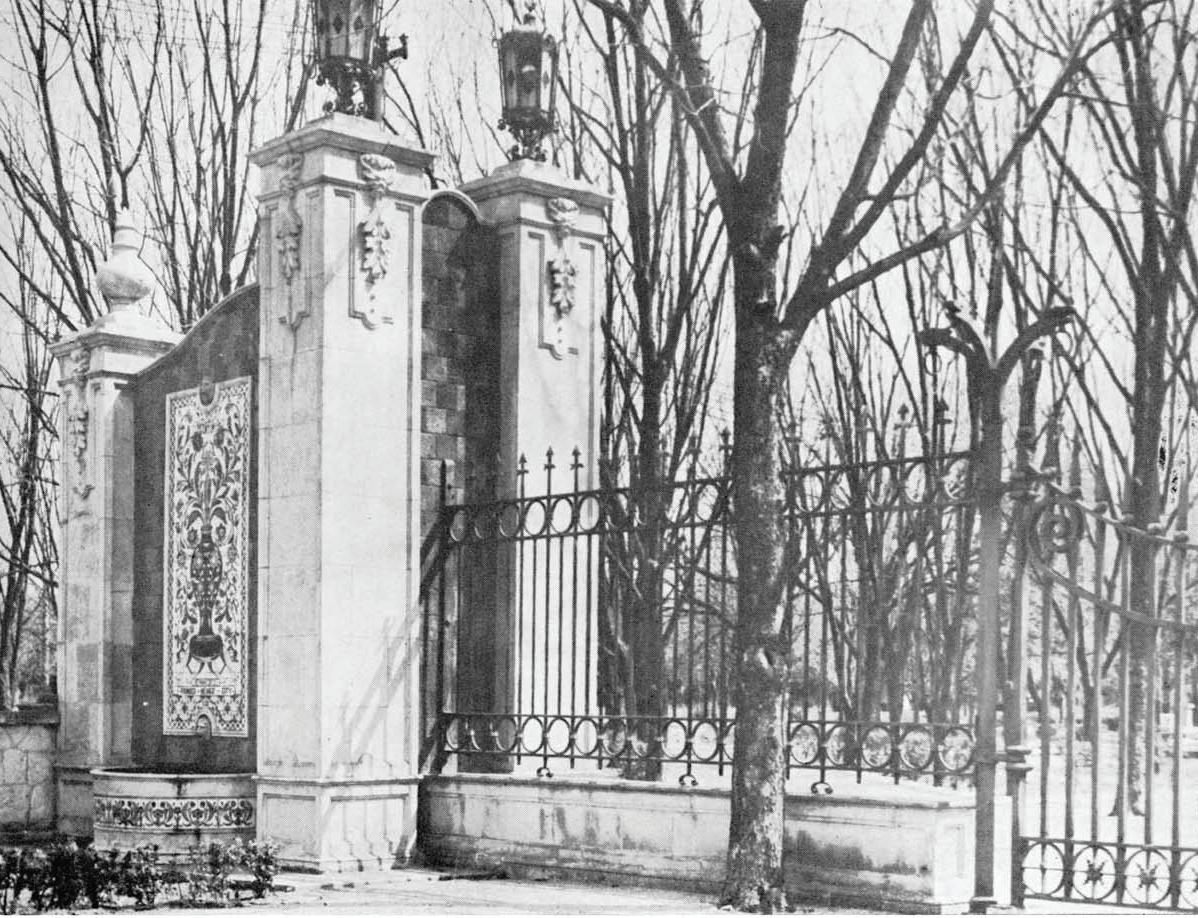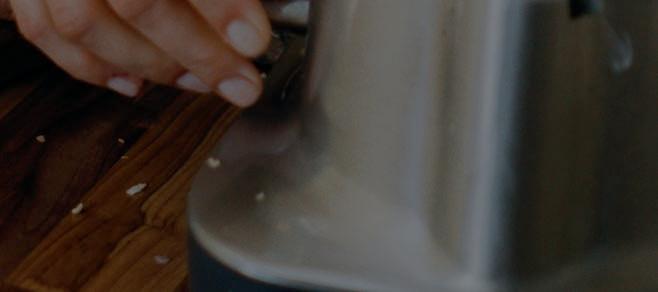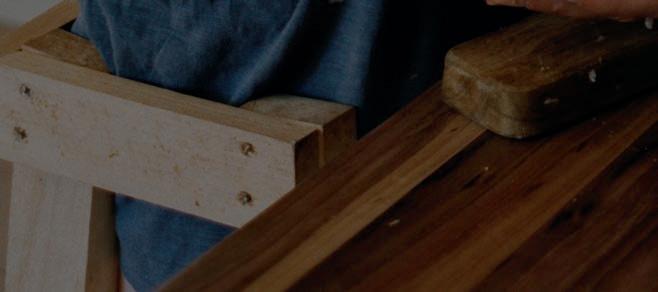
13 minute read
Arts
Anne Elise Urrutia
The Secret Garden
Advertisement
New book painstakingly recreates the mysterious San Antonio landmark Mirafl ores
BY BRYAN RINDFUSS
There’s a distinct sense of mystery to Mirafl ores, the gated green space viewable from Hildebrand Avenue near Broadway.
Evocative of Frances Hodgson Burne ’s early 20th-century novel The Secret Garden, Mirafl ores invites imaginative speculation and has unwi ingly welcomed countless trespassers. Many San Antonians who have driven past its ornate gates — which seemingly lead nowhere — have wondered what it is.
But the bigger question lies in what it was.
Writer Anne Elise Urrutia answers that in depth in her new Trinity University Press book Mirafl ores: San Antonio’s Mexican Garden of Mystery. A labor of love six years in the making, it employs archival photographs, maps, diagrams and a research-driven narrative to off er a virtual tour of the enigmatic landmark her great-grandfather Aureliano Urrutia began creating in 1921.
Born in 1872 in the Mexico City suburb of Xochimilco — a World Heritage Site famed for its picturesque canals and “fl oating gardens” — Aureliano Urrutia grew up with modest means during the Porfi rio Díaz era and benefi ted from the president’s education initiatives.
“Education started to become more available to people of the lower income classes,” Anne Elise Urrutia explained during a recent interview with the Current. “He wound up ge ing promoted into a very prestigious high school in the center of Mexico City. He was at the top of his high school class. … And Porfi rio Díaz sponsored his medical education through his entry into the army.”
During his two-year stint in the army, Aureliano Urrutia caught the a ention of Victoriano Huerta, a rising army colonel who became a general and eventually the dictatorial president of Mexico.
By the turn of the century, Aureliano Urrutia had emerged as one of Mexico’s premier surgeons. Opened in 1911, his 25-acre hospital complex Sanatorio Urrutia was surrounded by gardens, walking paths and outdoor sculptures. As Anne Elise Urrutia recounts in her book, Sanatorio Urrutia was also a cultural salon of sorts, where her great-grandfather’s friends and colleagues — “infl uential writers, historians, musicians, lawyers, artists, and doctors” — gathered for intellectual discourse.
Amid the turmoil of the Mexican Revolution, Aureliano Urrutia was appointed secretary of the interior — a brief but fateful position that made him a scapegoat for the atrocities of Victoriano Huerta’s rule and eventually led him to fl ee Mexico in 1914.
“His escape from Mexico was essentially sponsored by the United States government,” Anne Elise Urrutia explained. “He fl ed Mexico City and went to Veracruz with six or seven members of his family, [all] disguised as peasants. They were intercepted by the United States government and were given passage on a military ship — the only passengers on a military freight ship to Galveston.”
Sanctuary in San Antonio
Upon se ling in San Antonio, Aureliano Urrutia bought two properties on what would later become Broadway — one for his medical practice, the other for a mansion to house his family of 13. When his wife Luz Fernández de Urrutia died in 1921, he purchased the tract that would become Mirafl ores.
Loss — of his wife, his homeland, his culture — essentially fueled the creation of Mirafl ores. An avid gardener and art collector, the successful surgeon began fi lling his nascent garden with plants native to Mexico and commissioning Mexican artists to create monumental outdoor works.
Beginning with Luis L. Sanchez’s 1921 statue of the Aztec ruler Cuauhtémoc, the sprawling outdoor collection at Mirafl ores grew to include staircases, gates, bridges and a volcanic-style fountain by trabajo rústico pioneer Dionicio Rodríguez, a bust of Porfi rio Díaz and elaborate benches adorned with illustrative Talavera tile.
Perhaps the most recognized elements of Mirafl ores, the imposing gate “Monumento a la Ciudad de México” still stands guard on Hildebrand while the massive, tile-covered Urrutia Arch now resides at the San Antonio Museum of Art.
Full-scale buildings were constructed on the property as well, including a quaint country house dubbed Quinta Maria and a three-story watchtower with a conical roof, blue-andwhite tile detail and a bell. Located near the source of the San Antonio River, Mirafl ores sits atop underground springs and once boasted natural ponds. In homage to his roots along the canals of Xochimilco, Aureliano Urrutia celebrated these natural water features and commissioned a bridge that stretched across a pond and doubled as a stage for live entertainment. In its prime, Mirafl ores functioned as a sanctuary for quiet
Trinity University Press contemplation, a destination for meetings of the minds and a venue for special events ranging from chamber concerts and fundraisers to private parties.
In 1931, the garden welcomed the American Insti-


Josh Huskin Rebecca Schenker Anne Elise Urrutia


tute of Architects (AIA) for an “evening fi esta” complete with a fl amenco performance on the stage bridge. Among the guests at that AIA event was architect Atlee Ayres, who was fascinated by Aureliano Urrutia’s inventive use of Talavera tile throughout Mirafl ores.
During her extensive research, Anne Elise Urrutia dove deep into the history of Talavera.
“I learned a lot about the history of Talavera,” she said. “It’s defi nitely something that was brought by the Spanish colonists … but it’s also a craft that is indigenous to Puebla, Mexico. And the people of Puebla really embraced the making of Talavera tile.”
While Mirafl ores shows Aureliano Urrutia to be an early champion of Talavera, Anne Elise Urrutia suspects he actually might have been the fi rst person to bring it to the United States. At the very least, he was way ahead of the curve — as was architect Ayres, who helped embed Talavera tile into the cultural fabric of San Antonio through landmarks spanning from the McNay Art Museum and the Randolph Air Force Base Administration Building, also known as the Taj Mahal, to numerous residential projects.
Changing hands
In 1962, at the age of 90, Aureliano Urrutia sold Mirafl ores with a deed that stipulated it would be preserved as “a spot of beauty.” As Anne Elise Urrutia details in her book’s epilogue, that deed wasn’t properly upheld by subsequent owners USAA (1962-1974), Southwestern Bell Telephone (1975-2000) or the University of the Incarnate Word (20002006).
“During USAA’s ownership of Mirafl ores, the company encroached on the fi ve-acre garden, converting it to expand their parking lot, and added a small building and a conventional rectangular swimming pool to the southwest quadrant as a recreational area for their employees’ children,” she writes.
Although Southwestern Bell claimed it would “continue the preservation” of Mirafl ores, it leased the property to the Telephone Pioneers of America, a volunteer group that proceeded to drain and fi ll in a large pond, cut down trees, destroy pathways and install a 4,000-square-foot pavilion fl anked with barbecue pits and bathrooms. During this period, some of Mirafl ores’ key objects began decaying — and even disappearing.
Within a year of taking ownership, UIW destroyed Dionicio Rodríguez’s trabajo rústico fountain that once served as the joyous center of Mirafl ores.
“Not only did they take it apart, but the city came in and sealed the well that was powering that fountain,” Anne Elise Urrutia pointed out during conversation. “That was an artesian well that was drilled 150 feet down.”
The university a empted to relocate 14 works of public art and build a parking lot in the garden — both were unsuccessful — but managed to block a nomination that would have placed Mirafl ores on the National Register of Historic Places.
Uncertain future
Owned by the City of San Antonio since 2006, Mirafl ores is now listed on the National Register of Historic Places and is designated as a State Archaeological Landmark by the Texas Historical Commission. In 2019, the nonprofi t Brackenridge Park Conservancy signed a 10-year agreement with the city to manage Mirafl ores, then commissioned a cultural landscape report that indicates it has “great potential as a restoration candidate.”
During our chat with Anne Elise Urrutia, we asked the author what an ideal restoration might look like to her.
“It’s a good question,” she replied. “I worry a li le bit about what might happen in a restoration. I think there’s a tendency to sanitize things when they get restored. And there are a lot of diff erent interests at work. … Mirafl ores is now part of Brackenridge Park, and it belongs to the city — so the garden belongs to the public, to the people. How is that going to be incorporated into a restoration? Will there be access hours? Will there be security? Will there be maintenance? How are they going to reinstate waterways that were once there? There are huge logistics in terms of any sort of restoration. That said, on the other hand, you have a park like Central Park in New York City, which was a huge mess in the early 1980s. And they got it together and restored that park largely. … So, it’s not that it’s not doable. But the question is really, is it doable in San Antonio at this time? Is there the will to do it? … I don’t see it immediately.”
Will aside, funding is a sizable factor.
“I can pre y safely say that there is no money set aside for the overall restoration of Mirafl ores,” she added.
Although Anne Elise Urrutia hopes her book will generate interest in a thoughtful and comprehensive restoration of Mirafl ores, she also wrote it as a living record of sorts.
“What I really wanted to do was show what Mirafl ores was at the time,” she said. “Basically to recreate it in a book just in case it never gets restored.”
MFrom left: author Anne Elise Urrutia; the author’s interpretation of her great-grandfather’s largely non-extant garden, illustrated by Rebecca Schenker, AIA; Mirafl ores in ruins, 2012.
arts
Find more arts coverage every day at sacurrent.com

Tommy Escobar
‘Big Mike’ at Bat
San Antonio Missions’ new batboy is all about bringing an infectious energy to the fi eld
BY TOMMY ESCOBAR
The June sun beats down on Nelson Wolff Stadium as the San Antonio Missions get in some practice before a regular season game.
Music booms through the PA system, and the Minor League team’s players spread out across the diamond, fi ne-tuning their skills.
In the dugout, batboy “Big Mike” Garcia overlooks the fi eld like it’s his own personal kingdom. A beaming smile suggests there’s no other place the 31-yearold would rather be.
Garcia was a baseball fan from a young age, but born with a mental disability, he knew he’d face limitations pursuing a career as a pro athlete. That hasn’t stopped him from bringing his contagious brand of enthusiasm to two Minor League teams.
The San Antonio native is in his fi rst season as batboy for the Missions — his childhood dream job — and he’s already become a critical part of the club’s fabric, according to players and staff .
“It’s all a good family here. I love it,” Garcia said. “I was new here and didn’t know anybody on the team at fi rst, but I showed the team my hard work. Everybody started talking to me and congratulating me. They’re like my family.”
That camaraderie is clear during practice as Garcia hustles back and forth from the clubhouse, refi lls water coolers and whips up a batch of “Big Mike Special” Powerade. He’s met with handshakes and fi st bumps from every staff member, coach and player who crosses his path.
On game days, Garcia arrives at the stadium at 2 p.m. He stocks the fridge with water, brings out towels for the players, provides the game balls, hangs the umpires’ clothes in their lockers and gets the fi eld ready for his favorite part of the day: game time.
Although born in the Alamo City, Garcia’s family later relocated to the Houston area, where he a ended Clements High School and became batboy for its baseball team. He found his fi t with the sport.
After graduation, he a ended a job fair for the Sugar Land Skeeters, the Houston-area Minor League team later renamed the Space Cowboys. Through a program for hiring people with special needs, he landed a position as that club’s batboy.
His nine-year tenure with the Skeeters came at an exciting time. He was part of championship teams in 2016 and 2018 and became such a fan favorite that the club created a “Big Mike” bobblehead in his honor. Earlier this year, Minor League Baseball’s offi cial website published a profi le of Garcia, highlighting his enduring popularity in Sugar Land.
When he and his mother moved back to the Alamo City before the 2022 season, he reached out to the Missions, inquiring about bringing his skills to the team he’d grown up wanting to be part of.
New team, same enthusiasm
Since landing the position in San Antonio, Garcia has brought his signature blend of energy and charisma to his hometown team, winning the respect of both players and fans.
“Whenever he goes out and grabs the bats or gives the umpires balls, the fans scream ‘Big Mike’ every single time he’s on the fi eld,” Missions pitcher Thomas Eshelman said. “I understood the magnitude of how much he puts into this, and a lot of players come through here and know who ‘Big Mike’ is. So, it’s good to see he gets a lot of recognition for who he is.”
After each ba er’s time at the plate, Garcia sprints to retrieve the bat, waving his arms toward the crowd like a conductor with a symphony. He knows his job goes beyond picking up equipment.
Clearly, he knows his role as the spark plug that can ignite a dull crowd. Beyond that, he’s the helping hand when a teammate is down, and ultimately, the reminder of why we love baseball to begin with, members of the club maintain.
“There are some days when we’re down on the scoreboard, this guy [Garcia] goes out there and starts moving his arms and tries to get the fans going. I think they already love him here,” Missions Hi ing Coach Raul Padron said. “Outside of the fi eld, he’s a real humble person. [He’s] always checking to see if you need anything, and I think it’s important to have him around our players and our clubhouse.”
As Garcia stands just outside watching practice unfold, he mimics a pitcher’s throwing motions. There’s li le doubt he’d love to expand his role at Nelson Wolff Stadium.
“My next goal is actually to be signed to the Missions for the last game of the season and get an at-bat,” Garcia said. “If not that, I’d like to be called up to the [San Diego] Padres and be a batboy for them. It would be a blessing to fi nally be in the show.”
M‘Big Mike’ Garcia was so beloved by fans when he was batboy for the Sugar Land Skeeters that he had his own bobblehead.






MORNINGS
Every day is a chance to change. And it starts right where your day begins. One small change today—like making a healthy breakfast—can be a huge first step towards a better tomorrow. At University Health, we believe in the power of change. Because that’s where healthier begins. Find expert tips at UHchange.com.
What will you change today?










